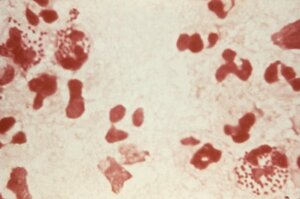
21 Sep USPSTF Updates Screening Review for Chlamydial and Gonococcal Infections
MedicalResearch.com Interview with:

Dr. Kubik
Martha Kubik, Ph.D., R.N.
Professor, School of Nursing
College of Health and Human Services
George Mason University
Member, U.S. Preventive Services Task Force
MedicalResearch.com: What is the background for this study? Are these infections increasing in incidence in the US?
Response: Chlamydia and gonorrhea are two of the most common sexually transmitted infections in the U.S. More people are being diagnosed with both of these STIs than ever, with nearly 2 million cases of chlamydia and more than 600,000 cases of gonorrhea reported in 2019, according to the CDC. Because most do not have symptoms, screening is vitally important to help ensure that these infections are discovered and treated, and serious health complications prevented.

CDC Image and Caption: This photomicrograph of a Gram-stained specimen revealed the presence of Gram-negative, Neisseria gonorrhoeae intracellular diplococci, leading to a positive diagnosis of gonorrhea.
MedicalResearch.com: What are the main findings of the underlying studies?
Response: Age is one of the most important risk factors for these sexually transmitted infections. Sexually active teens and young adults have the highest rates of infection with both chlamydia and gonorrhea. The Task Force recommends screening women and pregnant people who are 24 years old and younger, or who are 25 and older and at increased risk.
There is not enough evidence on the benefits and harms of screening men. The Task Force does not recommend for or against screening men and is calling for more research. Men who are concerned about STIs or their overall sexual health should talk with their clinician.
MedicalResearch.com: What should readers take away from your report?
Response: Chlamydia and gonorrhea are hard to detect because they often don’t cause symptoms; this is especially true for women. They are generally passed from one person to another during unprotected sexual contact. Screening is critical to prevent both the spread of infection and serious health problems. STIs in women can cause pelvic inflammatory disease (infection of a woman’s reproductive organs), infertility, ectopic pregnancy (a potentially life-threatening condition where the fertilized egg attaches somewhere outside the uterus) and chronic pain in the pelvic area. For both sexes, chlamydia and gonorrhea can increase the risk of getting or transmitting HIV.
MedicalResearch.com: What recommendations do you have for future research as a result of this work?
Response: The Task Force is calling for more research on screening men without symptoms. For example, more studies are needed on whether screening men reduces serious complications or reduces the spread of infection.
Additionally, the Task Force is calling for research on the benefits and harms of screening other groups at high risk, including men who have sex with men, members of the LGBTQ+ community, and people with a nonbinary gender identity.
MedicalResearch.com: Is there anything else you would like to add?
Response: The Task Force recognizes that both gender and biological sex are important when making decisions about how to stay healthy. In this case, due to both the research and the way these diseases are transmitted, the recommendation is based on biological sex, not gender identity. With that in mind, the Task Force recommends that people consider both their sex at birth and current anatomy to determine which recommendation best applies to them. If someone has any questions about which recommendation is the best fit, they should talk with their clinician.
Citation:
- Cantor A, Dana T, Griffin JC, et al. Screening for Chlamydial and Gonococcal Infections: Updated Evidence Report and Systematic Review for the US Preventive Services Task Force. JAMA. 2021;326(10):957–966. doi:10.1001/jama.2021.10577
2.US Preventive Services Task Force
USPSTF Recommendation: Screening for Chlamydia and Gonorrhea
US Preventive Services Task Force; Karina W. Davidson, PhD, MASc; Michael J. Barry, MD; Carol M. Mangione, MD, MSPH; Michael Cabana, MD, MA, MPH; Aaron B. Caughey, MD, PhD; Esa M. Davis, MD, MPH; Katrina E. Donahue, MD, MPH; Chyke A. Doubeni, MD, MPH; Alex H. Krist, MD, MPH; Martha Kubik, PhD, RN; Li Li, MD, PhD, MPH; Gbenga Ogedegbe, MD, MPH; Lori Pbert, PhD; Michael Silverstein, MD, MPH; Melissa A. Simon, MD, MPH; James Stevermer, MD, MSPH; Chien-Wen Tseng, MD, MPH, MSEE; John B. Wong, MD
Patient Information: Screening for Chlamydia and Gonorrhea
Jill Jin, MD, MPH
[subscribe]
[last-modified]
The information on MedicalResearch.com is provided for educational purposes only, and is in no way intended to diagnose, cure, or treat any medical or other condition. Always seek the advice of your physician or other qualified health and ask your doctor any questions you may have regarding a medical condition. In addition to all other limitations and disclaimers in this agreement, service provider and its third party providers disclaim any liability or loss in connection with the content provided on this website.
Last Updated on September 21, 2021 by Marie Benz MD FAAD
